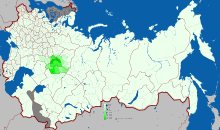Bashkir language
| Bashkir | |
|---|---|
| башҡорт теле, başqort tele, باشقۇرت تئلئ | |
| Native to | Russia |
| Region | mainly in Bashkortostan |
| Ethnicity | Bashkirs |
|
Native speakers
|
1.2 million (2010 census) |
|
Turkic
|
|
| Cyrillic, Latin, Arabic | |
| Official status | |
|
Official language in
|
|
| Language codes | |
| ISO 639-1 | ba |
| ISO 639-2 | |
| ISO 639-3 | |
| Glottolog | bash1264 |

Geographic distribution of Bashkir language in the Russian Empire according to 1897 census
|
|
The Bashkir language (Башҡорт теле, başqort tele, باشقۇرت تئلئ, pronounced [ˈbaʂqʊrt teˈle]) is a Turkic language belonging to the Kipchak branch. It is co-official with Russian in the Republic of Bashkortostan and has approximately 1.2 million speakers in Russia. Bashkir has three dialects: Southern, Eastern and Northwestern.
Speakers of Bashkir mostly live in the Russian republic of Bashkortostan. Many speakers also live in Tatarstan, Chelyabinsk, Orenburg, Tyumen, Sverdlovsk and Kurgan Oblasts and other regions of Russia. Minor Bashkir groups also live in Kazakhstan and other countries.
The Bashkirs in ancient times used the Old Turkic alphabet. After the adoption of Islam, which began in the 10th century and lasted for several centuries, the Bashkirs began to use Turki as a written language. Turki was written in a variant of the Arabic script.
...
Wikipedia
